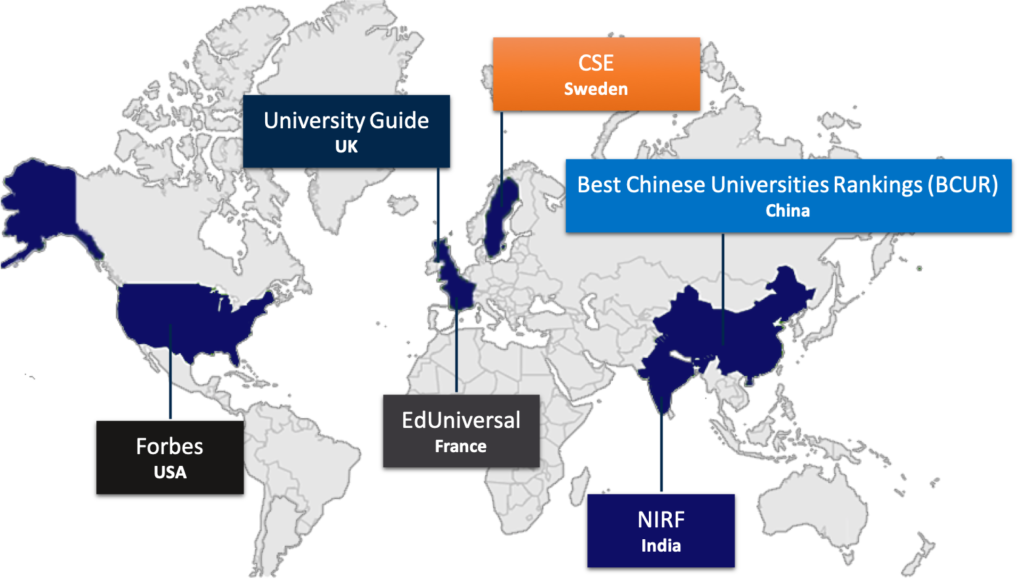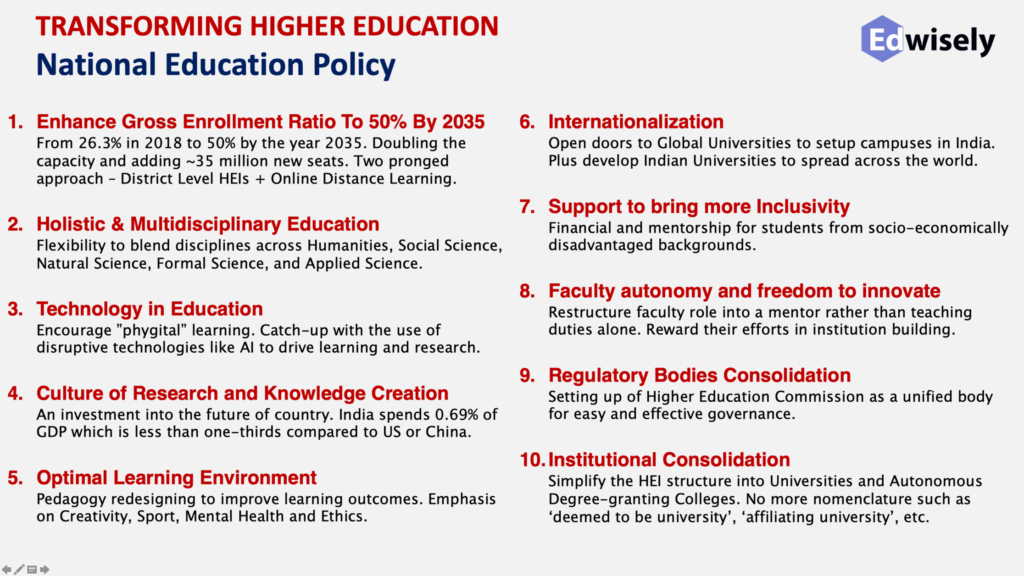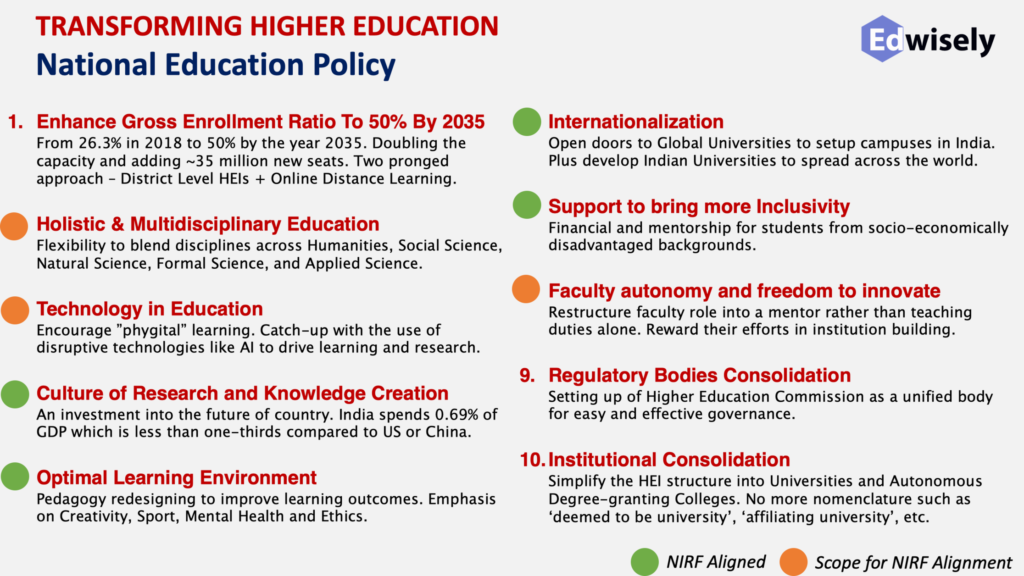
If a Higher Education Institution (HEI) has to improve its NIRF rank by 10 places, its best chance is to double its research efforts.
The number of research publications an institution publishes, together with its quality metric, carries 20% weightage in NIRF. This has the single highest correlation with the college’s NIRF rank.
So if you are part of the NIRF Task Force in your college, then you are almost definitely going to see an improvement if you roll out an action plan to step up your research game.
But why is research given such a large emphasis in NIRF? When students choose a college they hardly factor in research capabilities. Nor do parents. Not even companies who hire for placements.
The rest of the article explains why some parameters in NIRF carry those weights, how NIRF and NEP are tangled, and why a new NIRF parameter is inevitable.
For the uninitiated – A Brief Introduction to NIRF Rankings
Beginning with the student, and going all the way to the government, everyone is referring to the National Institutional Ranking Framework (NIRF) to make crucial decisions. Admissions, Government Funding, and Placements are all being influenced by an institution’s NIRF rank. That’s reality and that is going to stay.
Until 2015, credible institute ranking was from global agencies like QS or Times Higher Education, both announcing their World University Rankings each year. Popular websites like CollegeDunia.com which attracts students in swarms, also have a strong influence on students who look at differentiating metrics like fees and social life. The NIRF was the first one that got the government’s seal of confidence. Created and adopted by the Ministry of Education (at the time of creation it was called Ministry of Human Resource Development), the main objective of NIRF is to promote competitive excellence in Higher Education Institutions (or HEIs). It discourages complacency and encourages HEIs to become more reliable and responsible. A higher ranking means greater prestige and greater responsibility to create and deliver value.

National Education Policy 2020
The last National Education Policy was implemented in 1986. In these 34 years, till NEP 2020 was approved, there has been not one but multiple tectonic changes, in all aspects of life.
A panel led by former Indian Space Research Organisation (ISRO) chief Krishnaswamy Kasturirangan gathered ideas across the lengths and breadths of the country to draft this policy. It envisions an India-centric education system that contributes directly to transforming our nation sustainably into an equitable and vibrant knowledge society by providing high-quality education to all. It covers school, higher education, and vocational training.
The policy has 10 key points on Higher Education and all of them are seemingly audacious.

Since July 2020 when the policy was approved, the peak debating window on its pros and cons has passed, and now everyone has accepted that it is here to stay. It is time for NEP to be implemented.
But how can such an audacious policy that is set to change the course of nation’s education system after 34 years be implemented in such a short span of time?
Implementation of NEP is Difficult by Design as Education in the Indian Constitution is part of the Concurrent List. It means that both the Central Government and State Governments can make laws around it. Typically, the tone is set by the Union, and the individual States tune it as per their needs and aspirations. This makes it 10X harder for education reforms to go through.
Here we need a creative solution that will encourage HEIs to align themselves to NEP without any mandates.
That is where NIRF stands. NIRF is optional for colleges to participate in. But it is already constructed in a way that encourages HEIs to align themselves to NEP 2020.
A beautiful example of this is the way NIRF parameter Research and Professional Practice (RP) connects to NEP’s point on a Culture of Research and Knowledge Creation. By providing the highest weightage to RP, it is incentivizing HEIs to drive research within their institutions. At a time when India is poised for growth, having the right research mindset in HEIs will have a profound long-term impact.
This is just one of the parameters that are part of NIRF already which can drive NEP. In fact, four of the 10 points that are in the NEP 2020 Higher Education list, already have a driver-parameter in NIRF. Three more could potentially be added to the framework soon.

A Potential New NIRF Parameter: Learning Technology Utilisation
The COVID-19 crisis and ensuing pandemic have ravaged “life as we know it”. It has impacted the way India learns and teaches. HEIs had to upgrade themselves and adopt learning technologies. This turned out to be the primary resource for learning to continue uninterrupted during the pandemic.
This single parameter can thrust several agenda points of NEP
- Faculty to Student Ratio can increase multifold if technology and data are harnessed by the college. To guide each student, a self-guiding AI bot can have a dramatic impact.
- Data Analytics to provide to Central and State Government agencies much-needed inputs for data-driven decision making.
- Multi-disciplinary education leads to an Academic Bank of Credits for every student to securely track his formal learning throughout his lifetime.
- Continuous Assessment requires an efficient way to Conduct, Correct and Counsel students on their performance. It cannot be imagined without an AI-Based Platform.
- For Online Distance Learning the foundation lies in technology.
In conclusion, NIRF can be looked at as a lever to implement NEP 2020. It is a creative and gamified approach to take Indian Higher Education to the next level.
Source Article: https://www.linkedin.com/pulse/nep-2020-through-nirf-mechanics-change-yashwanth-tudimilla/

